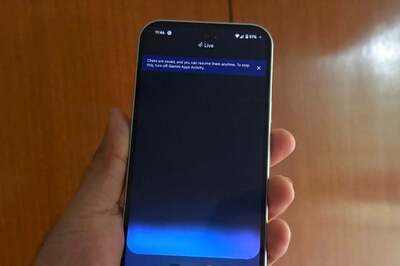
views
London: Facial recognition technology being considered for London's 2012 Games is getting a workout in the wake of Britain's riots, a senior police chief told The Associated Press on Thursday, with officers feeding photographs of suspects through Scotland Yard's newly updated face-matching program.
Chief Constable Andy Trotter of the British Transport Police said the sophisticated software was being used to help find those suspected of being involved in the worst unrest London has seen in a generation.
But he cautioned that facial recognition makes up only a fraction of the police force's efforts, saying tips have mostly come from traditional sources, such as still images captured from closed circuit cameras, pictures gathered by officers, footage shot by police helicopters or images snapped by members of the public. One department was driving around a large video screen displaying images of suspects.
"There's a mass of evidence out there," Trotter said in a telephone interview. "The public are so enraged that people who wouldn't normally come forward are helping us - especially when they see their neighbors are coming back with brand new TVs."
Prime Minister David Cameron acknowledged Thursday that police were overwhelmed by rioting that began over the weekend in London and spread across the country over four days. Mobs of youths looted stores, set buildings aflame and attacked police officers and other people - a chaotic and humbling scene for a city a year away from hosting the Olympic Games.
At an emergency session of Parliament summoned to discuss the riots, Cameron said authorities were considering new powers, including allowing police to order thugs to remove masks or hoods, evicting troublemakers from subsidized housing and temporarily disabling cell phone instant messaging services. He said the 16,000 police deployed on London's streets to deter rioters and reassure residents would remain through the weekend.
A press officer with Scotland Yard - who also spoke anonymously, in line with force policy - confirmed that facial recognition technology was at the police's disposal, although he gave few other details. He said that generally the technology would only be used to help identify those suspected of serious crimes, such as assault, and that in most cases disseminating photographs to the general public remains a far cheaper and more effective way of finding suspects.
The facial-recognition technology used by police treats the human face like a grid, measuring the distance between a person's nose, eyes, lips and other features. It has recently been upgraded, according to an article published last year in Scotland Yard's bimonthly magazine, "The Job."
The March 2010 article said that the new program has been shown to work far better than older versions of the technology, with one expert quoted as saying that it had shown promise in identifying people from high-quality, face-on shots taken off of surveillance photographs, mobile phones, passports or the Internet.
A law enforcement official told the AP that to use the technology "you have to have a good picture of a suspect and it is only useful if you have something to match it against. In other words, the suspect already has to have a previous criminal record."
He spoke on condition of anonymity because he was not authorized to discuss ongoing investigations.
In another effort to identify suspects, police have released two dozen photos and videos to the picture-sharing website Flickr, where they've already gathered more than 400,000 hits. Some of those photographs have also been published by Britain's brash tabloid press. The Sun recently plastered them across its front page, along with a headline urging readers to report looters to the police.
The photographs on Flickr are mainly grainy images pulled from cameras, which may not be of much use to face-matching software. But detectives are already scanning the Web for pictures of high-quality photographs of rioters' faces, according to photojournalist Guilherme Zauith, who witnessed some of the disturbances in London and later posted images of clashes to the Internet.
Zauith said he was recently contacted by a London detective "saying that they saw my photos online and if I could send it to them to help to identify the people."
"They were looking for all kind of photographs showing faces," he said. Zauith, a 30-year-old Brazilian national, said he turned the photos over to the detective.
The West Midlands police were trying another approach: driving a van equipped with a large screen displaying 50 images of suspects through Birmingham.
Police said the "Digi-Van" will stop at key locations around the city to give shoppers and commuters a good look at the photographs in hopes they can help identify suspects.
Facial recognition technology is already widely employed by free-to-use websites such as Facebook and Google Inc.'s Picasa photo-sharing program.
Such programs have been of increasing interest to authorities as well. A person with the Olympic planning committee, speaking to the AP on condition of anonymity because of the sensitivity of security preparations, said that facial recognition software was being considered for use as a security measure during the Olympic Games.
Meanwhile, detectives are employing a host of other tactics to take aim at the rioters. Police departments across the country have made arrests linked to riot threats and boasts posted to social networking sites.
Trotter said that while investigations had been helped by looters "who publicize their actions on things like Facebook," a lot of arrests have come the old-fashioned way, through officers simply spotting suspects they'd seen before.
"It's not just the face that is recognizable," Trotter said. "It's been in the way they walk, or the clothes they're wearing or even tattoos."



















Comments
0 comment